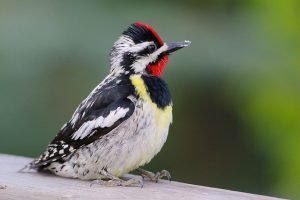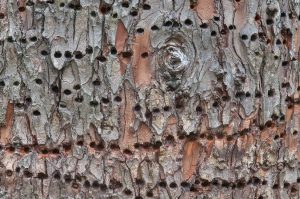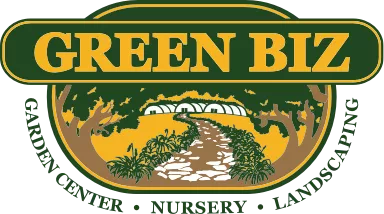That Pretty Little Pest
The Yellow Bellied Sap-Sucker comes from the woodpecker family. This pretty bird is a pest and will create lines of shallow holes in trees. These holes will leave trees susceptible to disease and insect damage.

Yellow Bellied Sap-Sucker
Identification
These small woodpeckers have bold colored feathers. The body is made up of black and white feathers, and the forehead boasts a bright red stripe. The males have brightly colored red neck feathers. The chests of these small pests have a splash of yellow coloring, hence the Yellow Belly.
Food
They feed on sap wells on trees. You can identify the evidence of a Yellow Bellied Sap-Sucker when you see neat rows of shallow holes. Sap-Suckers will often feed on suet feeders left out for the birds as well.
Tree Damage

Tree damage from a yellow-bellied sapsucker
Repeated feedings on one tree will cause enough damage to a tree that it will die from wood decay, fungus or bacteria that enters from the feeding holes left behind.
Discouraging the Yellow-Bellied Sapsucker
Discourage Sap-Suckers from feeding on your trees and structures. To do so, wrap hardware cloth or burlap around the areas that are being fed and pecked. The material will protect the tree from damage. You can also cover your wooden shed or other structures with a lightweight plastic bird-type netting to protect your outdoor structures.
To deter these birds you can use plastic twirlers fastened to the eaves, wrapping them in aluminum foil, or hanging compact discs and brightly colored plastic strips. Doing so will typically repel the birds. The birds do not like the movement or reflection these items provide. Unfortunately, repelling these birds from one tree won’t discourage them from feeding on a tree right next to it.
You Need to Know
In the United States, Yellow Bellied Sap Suckers are protected under the Migratory Bird Treaty Act. Also know that taking, killing or possessing this species is illegal without a permit.
